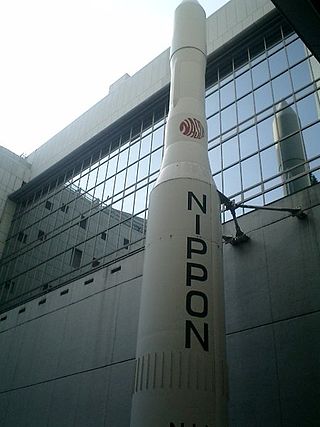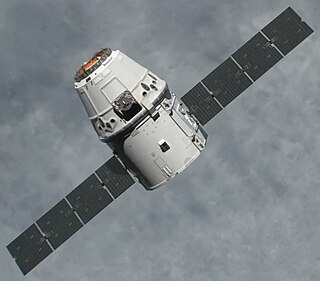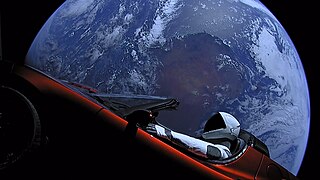Related Research Articles

An expendable launch system is a launch vehicle that can be launched only once, after which its components are either destroyed during reentry or discarded in space. ELVs typically consist of several rocket stages that are discarded sequentially as their fuel is exhausted and the vehicle gains altitude and speed. As of 2024, less and less satellites and human spacecraft are launched on ELVs in favor of reusable launch vehicles. However, there are many instances where a ELV may still have a compelling use case over a reusable vehicle. ELVs are simpler in design than reusable launch systems and therefore may have a lower production cost. Furthermore, an ELV can use its entire fuel supply to accelerate its payload, offering greater payloads. ELVs are proven technology in widespread use for many decades.

The Japan Aerospace Exploration Agency (JAXA) is the Japanese national air and space agency. Through the merger of three previously independent organizations, JAXA was formed on 1 October 2003. JAXA is responsible for research, technology development and launch of satellites into orbit, and is involved in many more advanced missions such as asteroid exploration and possible human exploration of the Moon. Its motto is One JAXA and its corporate slogan is Explore to Realize.

H-IIA (H-2A) is an active expendable launch system operated by Mitsubishi Heavy Industries (MHI) for the Japan Aerospace Exploration Agency. These liquid fuel rockets have been used to launch satellites into geostationary orbit; lunar orbiting spacecraft; Akatsuki, which studied the planet Venus; and the Emirates Mars Mission, which was launched to Mars in July 2020. Launches occur at the Tanegashima Space Center. The H-IIA first flew in 2001. As of February 2024, H-IIA rockets were launched 48 times, including 42 consecutive missions without a failure, dating back to 29 November 2003.
RAIKO is a Japanese satellite which was built and operated by Tohoku and Wakayama Universities. A two-unit CubeSat, RAIKO was deployed from the International Space Station (ISS) on 4 October 2012, having been launched on 21 July 2012.

The Tanegashima Space Center (TNSC) is the largest rocket-launch complex in Japan with a total area of about 9.7 square kilometers. It is located on the southeast coast of Tanegashima, an island approximately 40 kilometers (25 mi) south of Kyushu. It was established in 1969 when the National Space Development Agency of Japan (NASDA) was formed, and is now run by JAXA.

H-IIB (H2B) was an expendable space launch system jointly developed by the Japanese government's space agency JAXA and Mitsubishi Heavy Industries. It was used to launch the H-II Transfer Vehicle cargo spacecraft for the International Space Station. The H-IIB was a liquid-fueled rocket, with solid-fuel strap-on boosters and was launched from the Tanegashima Space Center in southern Japan. H-IIB made its first flight in 2009, and had made a total of nine flights through 2020 with no failures.
Information Gathering Satellite are the satellites of the Japanese spy satellite program. It was started as a response to the 1998 North Korean missile test over Japan. The satellite program's main mission is to provide early warning of impending hostile launches in the region. This program is under the direct control of the cabinet. All Information Gathering Satellites have been launched by H-IIA rockets from the Tanegashima Space Center.
JAXA Engineering Test SatelliteETS-VIII was the eighth technology test satellite in a series which started with ETS-1 in 1975 by NASDA. It was launched with the H-2A on December 18, 2006. ETS-VIII was developed by JAXA in cooperation with NICT and NTT. The aim of ETS-VIII was to enable satellite communications with small terminals. Unlike the Iridium satellites for mobile communication, ETS-VIII was positioned at GEO. However to fulfill the task, it was essential that the satellite carried two very large antennas. It was the first use of the 204 configuration of the H-IIA launch vehicle.

Several significant events in spaceflight occurred in 2009, including Iran conducting its first indigenous orbital launch, the first Swiss satellite being launched and New Zealand launching its first sounding rocket. The H-IIB and Naro-1 rockets conducted maiden flights, whilst the Tsyklon-3, Falcon 1 and Ariane 5GS were retired from service. The permanent crew of the International Space Station increased from three to six in May, and in the last few months of the year, Japan's first resupply mission to the outpost, HTV-1, was conducted successfully.

The N-I or N-1 was a derivative of the American Thor-Delta rocket, produced under license in Japan. The N stood for "Nippon" (Japan). It used a Long Tank Thor first stage, a Mitsubishi Heavy Industries-designed LE-3 engine on the second stage, and three Castor SRMs. Seven were launched between 1975 and 1982, before it was replaced by the N-II. Six of the seven launches were successful, however on the fifth flight, there was recontact between the satellite and the third stage, which caused the satellite to fail.
The N-II or N-2 was a derivative of the American Delta rocket, produced under licence in Japan. It replaced the N-I-rocket in Japanese use. It used a Thor-ELT first stage, a Delta-F second stage, nine Castor SRMs, and on most flights either a Star-37E or Burner-2 upper stage, identical to the US Delta 0100 series configurations. Eight were launched between 1981 and 1987, before it was replaced by the H-I, which featured Japanese-produced upper stages. All eight launches were successful.

The year 2012 saw a number of significant events in spaceflight. In May and October, the first Commercial Orbital Transportation Services resupply missions took place, during which the SpaceX Dragon became the first private spacecraft to dock with the International Space Station (ISS). In June, China launched the crewed Shenzhou 9 orbital mission, and North Korea achieved its first successful orbital launch in December. 2012 also saw China's first successful asteroid exploration mission, and the landing of NASA's Curiosity rover on Mars. The Vega and Unha-3 rockets made their maiden flights in 2012, while the Proton-K made its last.
Hayato, known before launch as KSAT, or the Kagoshima Satellite, is a Japanese satellite which was launched on 20 May 2010. It is a student-built spacecraft, which is operated by Kagoshima University, and is being used for technology demonstration and atmospheric research. The satellite is a single unit CubeSat, and carries equipment to study water vapour in the Earth's atmosphere, microwave imagery and spacecraft communication.

In 2015, the maiden spaceflights of the Chinese Long March 6 and Long March 11 launch vehicles took place.

In 2014, the maiden flight of the Angara A5, Antares 120 and Antares 130 took place.

In 2013, the maiden spaceflight of the Orbital Sciences' Antares launch vehicle, designated A-ONE, took place on 13 April. Orbital Science also launched its first spacecraft, Cygnus, that docked with the International Space Station in late September 2013.

This article compares different orbital launcher families. The article is organized into two tables: the first contains a list of currently active and under-development launcher families, while the second contains a list of retired launcher families.

This article documents notable spaceflight events during the year 2018. For the first time since 1990, more than 100 orbital launches were performed globally.

Himawari 9 is a Japanese weather satellite, the 9th of the Himawari geostationary weather satellite operated by the Japan Meteorological Agency. The spacecraft was constructed by Mitsubishi Electric, and is the second of two similar satellites to be based on the DS-2000 bus.
References
- ↑ "Launch Result of IGS #2/H-IIA F6". JAXA. 29 November 2003. Archived from the original on 25 September 2011. Retrieved 19 June 2013.
- 1 2 3 4 Space Launch Report: H-IIA/B Data Sheet, Retrieved 20 February 2019
- ↑ "Launch Result of the IBUKI (GOSAT) by H-IIA Launch Vehicle No. 15". MHI and JAXA. 23 January 2009. Archived from the original on 21 June 2013. Retrieved 13 March 2018.
- ↑ "H-IIA F16". Sorae. Archived from the original on 18 February 2012.
- ↑ "Launch Day of the H-IIA Launch Vehicle No. 17". JAXA. 3 March 2010. Archived from the original on 3 June 2013. Retrieved 13 March 2018.
- ↑ "Overview of Secondary Payloads". JAXA.
- ↑ Tariq Malik (18 May 2010). "New Venus Probe to Launch Thursday From Japan After". Space.com. Retrieved 20 May 2010.
- ↑ Chris Bergin (17 May 2010). "JAXA launch H-IIA carrying AKATSUKI and IKAROS scrubbed". NASASpaceflight. Retrieved 17 May 2010.
- ↑ "New Launch Day of the First Quasi-Zenith Satellite 'MICHIBIKI' by H-IIA Launch Vehicle No. 18". JAXA.
- ↑ Chris Bergin (23 September 2011). "Japanese H-2A launches with new IGS military satellite". NASASpaceflight.
- ↑ Chris Bergin (11 December 2011). "Japanese H-2A lofts IGS (Radar-3) satellite into orbit". NASASpaceflight.
- ↑ "Launch Overview – H-IIA Launch Services Flight No.21". Mitsubishi Heavy Industries. Archived from the original on 15 October 2017. Retrieved 15 April 2012.
- ↑ Clark, Stephen (18 April 2016). "Attitude control failures led to break-up of Japanese astronomy satellite". Spaceflight Now. Retrieved 21 April 2016.
- 1 2 "Explanatory Statement – Request for Special Temporary Authority for Launch Services" . Retrieved 18 April 2024.
- 1 2 3 4 5 6 7 8 9 10 11 12 13 14 15 16 17 18 19 20 21 "宇宙基本計画⼯程表 (令和5年度改訂)" [Basic Plan on Space Policy (2023 Revision)](PDF) (in Japanese). Cabinet Office. 22 December 2023. p. 45. Archived (PDF) from the original on 25 December 2023. Retrieved 26 December 2023.
- ↑ Ryan, Dorothy (3 December 2020). "Lincoln Laboratory is designing a payload to integrate on Japanese satellites". MIT . Retrieved 29 April 2021.
The laboratory is working with the Japanese National Space Policy Secretariat and Mitsubishi Electric Company to integrate state-of-the-art sensors on the newest satellites in the QZSS constellation, QZS-6 and QZS-7, which are scheduled for launch in 2023 and 2024, respectively.
- ↑ "技術試験衛星9号機(ETS-9)の開発状況について" [About the development status of Engineering Test Satellite No. 9 (ETS-9)](PDF). MEXT (in Japanese). 28 June 2021. Retrieved 7 September 2021.
- ↑ "Japan to Delay Mars Moon Exploration by 2 Years to 2026". Yomiuri Shimbun . 6 December 2023. Retrieved 26 December 2023.
- ↑ Bessho, K. (26 April 2023). Status of Himawari-8/9 and their follow-on satellite Himawari-10. CGMS-51. JMA . p. 5. Retrieved 7 December 2023.
- ↑ "The origin of the Universe will be unveiled by the LiteBIRD cryogenic satellite". Grenoble Alpes University . 3 July 2023. Retrieved 26 December 2023.
- ↑ Montier, L. (10 July 2019). "LiteBIRD Overview" (PDF). IN2P3 . Retrieved 29 April 2021.
- ↑ Jones, Andrew (27 November 2020). "Japan's new H3 launcher delayed by rocket engine component issues". SpaceNews . Retrieved 29 April 2021.
- ↑ Krebs, Gunter (17 March 2021). "H-2A". Gunter's Space Page. Retrieved 29 April 2021.
- ↑ Krebs, Gunter (5 October 2020). "H-3". Gunter's Space Page. Retrieved 29 April 2021.